Bergenia spp.
If you’re anything like I am, it’s easy for you to fall in love with a new plant, sometimes based on its picture alone.
For me, bergenia is such a plant. I find it difficult to resist a glossy photo of those gorgeous flowers and tantalizing leaves.
Unfortunately for those of us in warmer climates, most types grow best in cooler Zones 4 to 6, although many can be grown in warmer locations through Zone 9.
While some English gardeners wax poetic about bergenia, these stunning plants are grown much less frequently in the US than they should be, considering their plethora of positive attributes – not the least of which is that they are next to impossible to kill!

We link to vendors to help you find relevant products. If you buy from one of our links, we may earn a commission.
This easy-care plant may help to literally fill a void in many gardens, and yours could be next.
If you don’t like pink flowers, you can choose from red, white, and purple varieties, depending on your preference.
This guide will describe how best to grow these non-fussy plants that will tolerate practically anything but overwatering!
What You’ll Learn
What Is Bergenia?
Bergenia is a genus of 10 species of flowering perennials from central Asia and Siberia.
These are regions that go from subfreezing in the winter to downright hot in the summer, and bergenia plants are well adapted to such climates. Their native habitat ranges in temperature from -35 to 115°F.
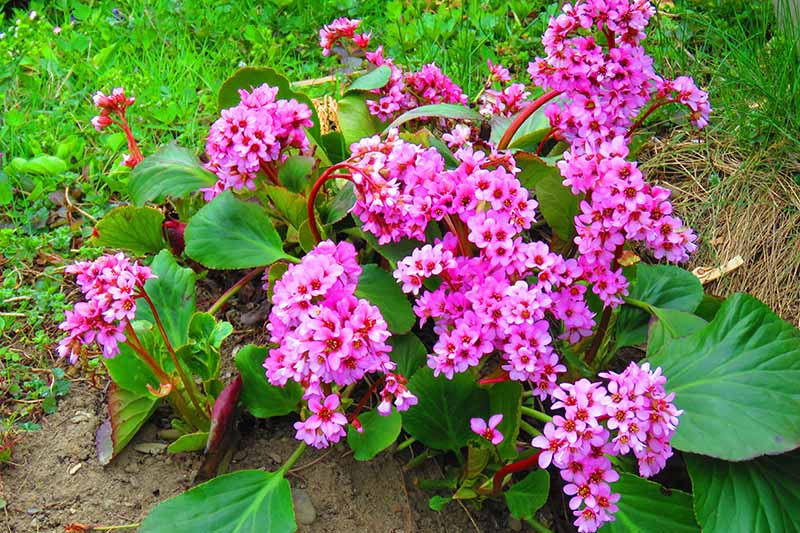
While these plants are usually just called bergenia, pigsqueak is an alternate name for them. It derives from the sound that the leaves of some types make when rubbed between a thumb and forefinger – like the squeal of a pig!
Less commonly, these plants are known as elephant ears (not to be confused with Colocasia), because the leaves of some cultivars are shaped like the ear of an elephant.
One name that is more common in Europe is Megasea, which was the scientific name for the genus at one point. Additional names include Siberian tea, and saxifrage.
Cobbler’s plant is another. Bergenia contains high amounts of tannins, and cobblers used to use the roots of certain plants to tan leather.
The plants make fantastic ground covers, with evergreen leaves in pleasing shades of dark green that turn reddish, bronze, or purple in the winter in cooler climates, depending on the species or cultivar.
This is followed by stunning flowers in the late winter to late spring, depending on the growing zone and variety.
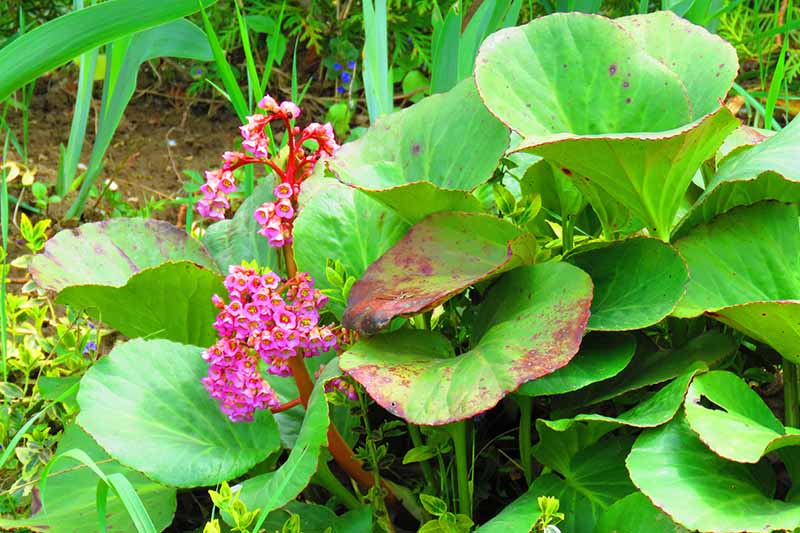
These plants prefer shade and will grow under trees. They are tolerant of deer and rabbits, and have few pest or disease problems.
Moist soil is preferred, but it must drain well. Overwatering is a major threat to these plants and one of the few common culprits that can kill them.
Bergenia spreads by short underground stems that produce new plants, and another bonus of growing these is that they suppress almost all types of weeds!
Cultivation and History
Bergenia plants are very popular in Europe and have been cultivated there for hundreds of years.
They are well traveled botanically, according to Gerald Klingaman, retired Extension Horticulturalist for the University of Arkansas.
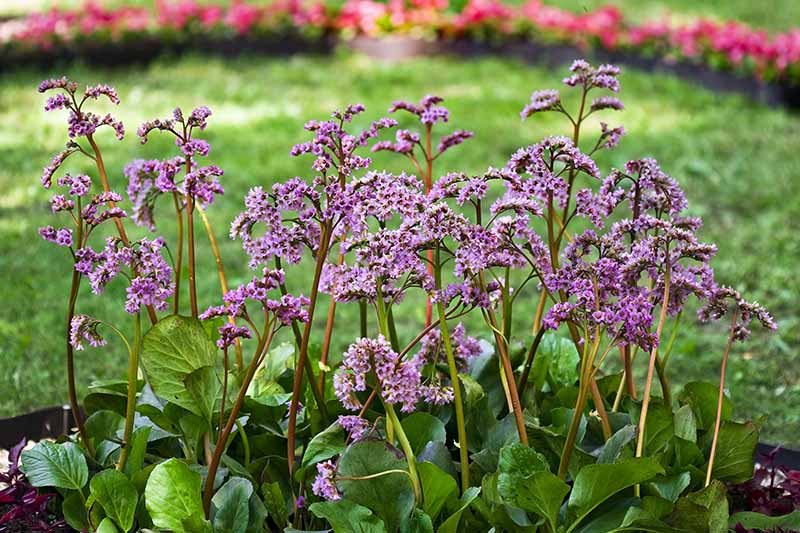
According to Klingaman, the plants first came to prominence when collected by David de Gorter, botanist and royal physician at the court of Empress Elizabeth of Russia from 1709 to 1762.
De Gorter sent these specimens to the famous taxonomist Linnaeus, who described them originally as a species of Saxifraga.
Taxonomy is perhaps the most contentious area of botany, and this plant has been through a bit of an identity crisis.
The German botanist Conrad Moench then named the plants Bergenia in honor of the German botany professor Karl A. von Berganin, noted in his Methodus Plantas in 1794.
That change did not solve the issue, since other scientists reclassified them as Megasea, then Saxifraga again.
Finally, the poor plants received their final name of Bergenia in the 1950s, based on standard taxonomic criteria used at the time.

The most common cultivated species is Bergenia crassifolia.
When it was collected in Siberia in 1779, B. cordifolia was thought to be a new species, but this is now considered a synonym for B. crassifolia. (Today, you can find plants for sale by both names.)
German and English breeders created a number of hybrids from the early 1900s through the 1980s, many of which remain popular to this day.
Current breeding efforts tend to focus on developing hybrids and cultivars that can handle heat better, to satiate the plant lust of southern growers like me, who wish to grow these flowers in their full glory in a warmer climate.
Propagation
The best method of propagating bergenia is by taking divisions of existing plants, and many nurseries carry live plants ready for transplanting into the garden as well.
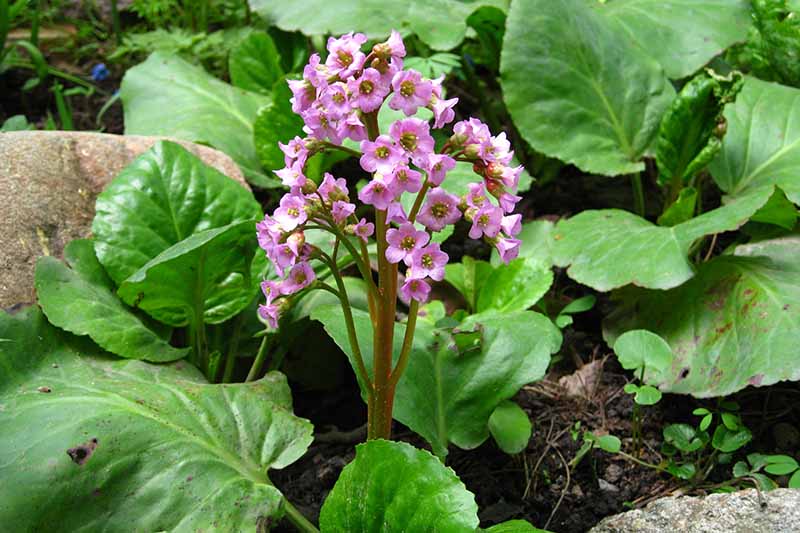
Plants may also be grown from seed, though this is less common and requires more of an investment of time.
Some gardeners have reported success with rooting leaf cuttings as well, though this method is beyond the scope of this article.
From Division
Spreading via rhizomes, or underground stems, mature plants can become too dense in the middle over time.
Since you will typically need to divide bergenia plants every three to five years, this is the perfect time to propagate new plants as well.
If the plants could thank you, they would, since the centers die out after they have grown in the same spot for a number of years.
The best time to divide them is after the flowers have died back in the spring, or in the autumn.
Dig up the parent plant, being sure to dig deep enough to reach the bottom of the root mass.
Split it into three or four parts with a sharp knife, taking care to cut each section of rhizome into one-and-a-half to two-inch lengths, each with several dormant buds intact.
Plant each division in its own hole, spaced at least 15 inches apart at the same depth to which they were growing before, to give them space to spread.
If you aren’t ready to replant right away, you can also cut away any roots and foliage from the divided rhizomes, and partially bury them in perlite or compost in a tray with the buds facing up, leaving the upper surface uncovered.
Keep the cuttings humid by covering the tray with plastic or glass, and put them in a partially shaded area that only receives indirect light with a temperature around 70°F.
In 10 to 12 weeks, the cuttings should root. When the new plants grow leaves, transplant them to pots or a nursery bed. They should bloom in one or two years.
From Seed
If you like surprises, you can save the seeds from your plants to grow new ones.
To save your own seeds, allow the seed heads to dry on the plants and remove them. Look for a structure that resembles a pair of bowling pins.
Crush it, and then collect the seeds. They will be very small, only the size of grains of dust.
If properly cleaned, the seeds can be stored.
Bergenia seeds collected from gardens often produce plants that look different from their parents due to cross-pollination, naturally creating new hybrids.
Only sow seeds you collected if you don’t have your heart set on growing one particular type.
Cold stratify seeds in a sealed plastic bag in the refrigerator for two weeks before planting.
You can plant them in your garden in the spring or fall. However, they are more likely to germinate if you start them indoors and transplant them.
The seedlings are more likely to grow in porous, sandy soil. Sow about four seeds per cell, or give them a few inches of space planted in rows in larger trays.
Do not bury the seeds in the soil – they also need light to germinate.
To grow them indoors, use sterile soil, preferably a starter mix. The soil should be at least 55°F, preferably 72°F or warmer. Be sure to keep it moist.
Give them two to three weeks to germinate before you start to worry about them. And be aware that the seeds can germinate unevenly, with some sprouting long before others.
Don’t give up! These seeds can take as long as six months to sprout.
From Seedlings/Transplanting
Transplant seedlings into your garden after the last frost of the season.
Plant them about 15 to 30 inches apart in the shade, depending on the requirements of your selected variety, and water them regularly until they are established.
If you are transplanting large plants purchased from a nursery, do so in the fall, or after they have finished blooming in the spring.
Start with root-bound plants in gallon-sized pots, since young plants take a while to get established.
Dig a hole that is twice the width of the root ball, fill the soil in around it, and tamp it down gently but firmly, making sure that the surface of the transplant is even with the rest of the soil.
Water thoroughly, and then water again only when the soil is extremely dry, until the plants settle in and start putting on new growth.
How to Grow
Bergenia plants thrive under large trees where many other plants will not grow, including walnut trees! They are resistant to juglone.
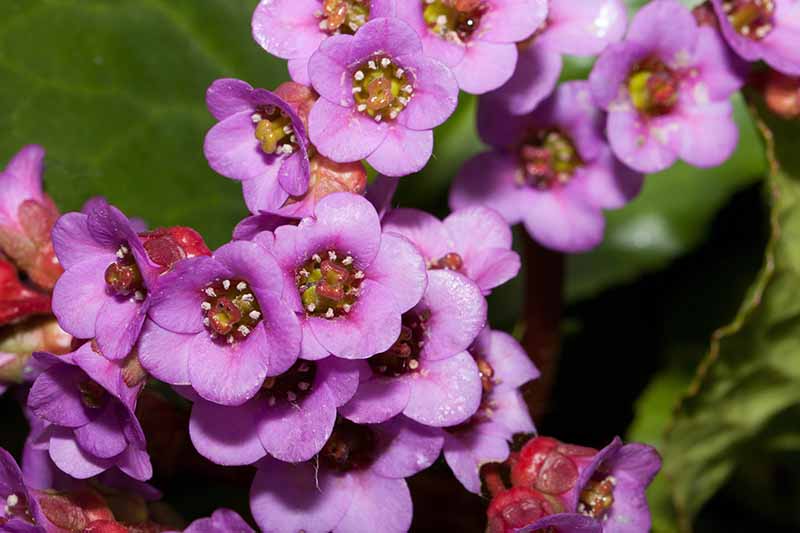
Growing tips vary depending on the conditions in your region, so be sure to heed the following recommendations.
Warmer Climates
Bergenia often struggles with humidity in southern zones, and gardeners in warmer climates may find that these species grow less vigorously than they might in cooler locales.
In warmer climates, such as that of Arkansas (Zones 7-8a), plant them on the north or northeast side of your garden, so they will receive some afternoon shade.
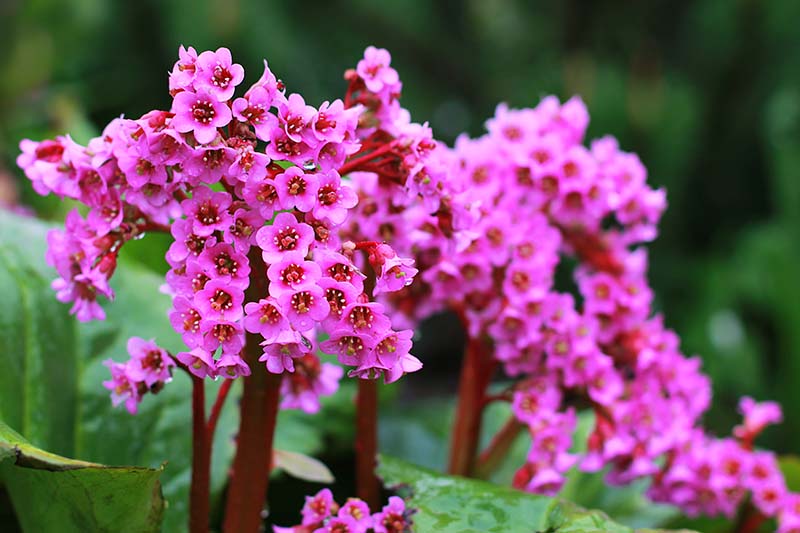
Bergenia is perfect for a shade garden in such climates! Treat them like camellias and azaleas.
If you do plant them in full sun, apply about two inches of mulch around the base of each plant. This will help prevent damage to the roots from the heat of the sun, and reduces the need for frequent watering.
Be careful to avoid covering the crown of the plant, or it could end up with crown rot.
If they are planted in full sun in a warm climate with no shade, there is a good chance that they will suffer.
You could end up with shorter plants with burnt leaves that look rusty around the edges. Even so, these plants will typically survive and keep spreading.
Water sparingly when it is hot and humid, since overwatering is a major threat to their existence. These plants can develop root rot if they are watered too frequently.
If you live in a hot, dry climate, put two to three inches of mulch on the surface of the soil to help keep the roots moist.
Cooler Climates
If you live in a cool climate, such as that of South Dakota (Zones 3-5), you can plant them in full sun without any pushback.
The flowers can be damaged by cold weather, since the buds are less cold-hardy than the leaves. However, growing them near a windbreak can help to prevent this from happening.
Appropriate options include boulders, shrubs, or ornamental trees or grasses.
In some cases, frost sensitive types such as B. ciliata may be grown indoors as houseplants to avoid exposure to severe winter weather.
Soil and Watering
Good drainage is a key factor to the survival of these plants – more important even than the amount of light that they receive.
While under-watered plants may grow more slowly, this is much better than providing too much water.
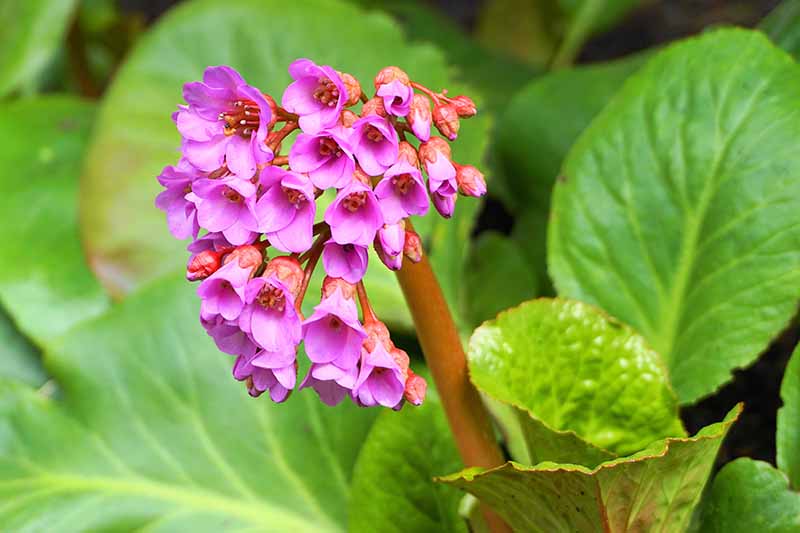
The only time you should water is when the plants have become really dry.
One way you can tell whether the plants need water or not is to check the top inch or two of the soil for moisture. If it is dry, water thoroughly, and then don’t water again for a while.
Remember: too little water is much better than too much.
Note that plants positioned in full sun will require more water than those growing in the shade.
Bergenia will tolerate a wide range of pH values – from acidic to neutral to alkaline. However, the plants will suffer in soil that is too alkaline.
Do a soil test, avoid soils with a pH of 7.5 or above, and amend accordingly before planting if you have to.
Bergenia plants are at their best in moist, humus-rich soil. But these plants are not too fussy about what type of soil they are grown in. This can include soil that is sandy, loamy, or even heavy soil with a lot of clay.
If your soil falls into the latter category, you should add some grit to it, to improve drainage.
There can also be an advantage to planting bergenia in poor soil and areas of the garden with a lot of sun exposure. This can enhance the purple or reddish leaf color in the fall for cultivars such as ‘Purpurea,’ for example.
Growing Tips
- Do not overwater.
- Plant in soil with good drainage.
- Grow against a windbreak in cooler zones.
Maintenance
Looking for a low maintenance plant? Look no further, because you have found one with Bergenia.
There are only two things you need to do to keep these plants at their best:
1. Remove Dead Leaves in the Spring
If the leaves have been damaged due to a harsh winter, cut plants to the ground in early spring.
Since these plants are evergreen, do not remove the leaves in the fall. The leaves are needed to protect the crown and encourage the development of next season’s flower buds.
2. Cut Dead Flower Stalks to the Ground
If you do this as needed, your plant may reward you by sending up new flower stalks!
This is good news, since each flower spike usually lasts only for a couple of weeks.
Otherwise, these are incredibly undemanding plants. They typically don’t even need to be fertilized unless the soil has very few nutrients.
If you wish, you can apply a slow-release fertilizer in the spring, when the plants have emerged from dormancy.
Species to Select
In addition to the 10 species in the Bergenia genus, there are hundreds of cultivars available. We have chosen some of the most commonly grown ones to introduce to you.
B. ciliata
Also known as frilly or hairy bergenia, this native of Tibet and Afghanistan can grow in Zones 5 to 9, and can withstand frost in the cooler parts of this suggested range.

This species produces shiny green leaves that can grow to be nearly a foot across. Plants have a spread of up to four feet, and the clumps this species makes are much less dense than those of most bergenias.
The leaves have the best color when grown in a sunny location with poor soil, a visible stress response, although the plants prefer cool and moist shade.
The experts at Washington State University Clark County Extension state that frilly bergenia is at its best when allowed to spread under the shade of a deciduous tree, and consider it to be one of the best to plant as ground covers.
Flowers grow on six-inch stems and they are typically pink, although they can also be white or purplish. And they are slightly fragrant!
The only downside for this variety is that it is less hardy, and its leaves can suffer frost damage. Some gardeners provide shelter for these plants during cold weather, since they are more tender than other varieties.
B. crassifolia
Best known as heartleaf bergenia (and sometimes winter blooming bergenia), this is the most commonly grown species. There are a number of varieties of this plant, many of which originally hail from Siberia.
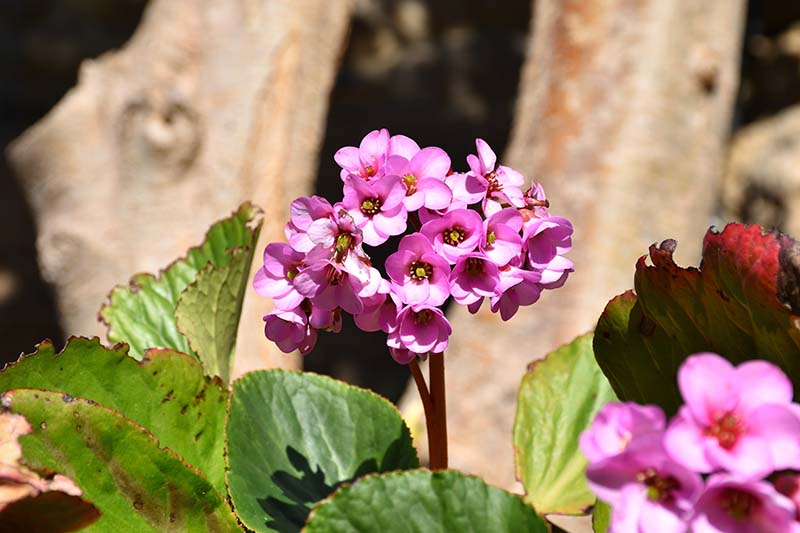
Synonyms for this species include B. cordifolia, Saxifraga crassifolia, and S. cordifolia, as well as others.
The dark green leaves are heart-shaped and wavy, with sparsely toothed margins. Their edges may turn red during the winter.
This is reportedly more likely to occur in the varieties that originated from Siberia than in species or cultivars from other parts of Asia.
The flowers are pinkish-purple, and they grow on 12- to 18-inch stems that are positioned well above the leaves.
These flowers draw bees and other pollinators, and shaded borders and foreground plantings are recommended uses for this plant in Zones 3 to 8.
You can find plants listed as B. cordifolia available from Nature Hills Nursery.
B. emeiensis
B. emeiensis, aka Chinese bergenia, is native to the Himalayas. Although the plant was first officially collected in 1935 from Mount Emei, one of the four sacred Buddhist mountains of China, it wasn’t named until 1988.
It is only now becoming prominent thanks to the efforts of Mikinori Ogisu, who introduced it to the West.

In contrast to most other types of bergenia, it prefers shady conditions even in warmer growing zones, with soil rich in humus.
The leaves are longer than they are wide and pale green in color, while the soft pink flowers are slightly spidery and droopy.
B. purpurascens
Known as purple bergenia, purple pigsqueak, and winter red bergenia, this plant has leaves that emerge purple before becoming glossy green. Its flowers can range from pink to red to purple.
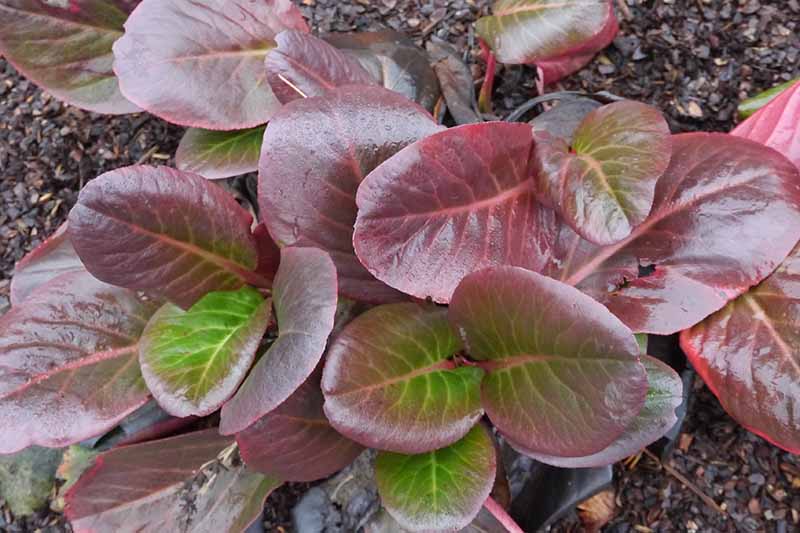
This species is also commonly known as Chinese bergenia, not to be confused with B. emeiensis. Its rhizomes have been used in traditional Chinese medicine to stop bleeding, and as a tonic.
Well suited to serving as a ground cover, bedding or border plant, or as an understory plant in woodlands, the RHS bestowed its prestigious Award of Garden Merit upon this species in 1993.
At its best in Zones 4 through 8, it will tolerate conditions in Zone 9, and is a recommended variety for the Midwestern and Eastern regions of the US.

You can buy seeds for B. purpurascens from Hazzard’s Seeds via Amazon.
B. purpurascens var. delavayi is an evergreen variety with deeply colored oval and erect purple-bronzed to reddish stems, and leaves with an open habit.
The color gets brighter in full sun, or when the weather is cold.
These plants produce deep pink flowers held in pendant-shaped clusters.
B. stracheyi
Strachey’s elephant ears, also known as B. milesii, is a compact evergreen variety with a clumping habit that is winter hardy in Zones 5 through 8.

It grows to nearly eight inches in height, and its oval green leaves have hairy margins and turn red in the winter.
This species can grow in full shade, partial shade, or even full sun in its recommended range. How unfussy is that?
The pink flowers have a slight fragrance and are borne on short stems. They draw bees and other pollinators.
Want More Options?
Be sure to check out our supplemental guide, “25 of the Best Bergenia Cultivars for the Garden,” to find the best choice for your landscape.
Managing Pests and Disease
One of the best things about this plant is that it is seldom bothered by insect pests and diseases – or deer and rabbits!
Insects
There is only one major pest of this plant, and it usually only inflicts minor damage.
Black vine weevils (Otiorhynchus sulcatus) may eat the edges of the leaves, giving them a notched look. Affected foliage can be cut back in the spring to clean up your plants’ appearance as the result of a minor infestation.
There is also some debate about how much of a problem snails and slugs are to bergenia.
Some experts say that the older leaves attract slugs, while others say that slugs generally leave these plants alone – particularly newer cultivars, such as ‘Pink Dragonfly’ and ‘Bressingham White.’
If you see signs of feeding, check out our guide to controlling slugs and snails for help.
Read more about identifying and controlling bergenia pests here.
Disease
Diseases in bergenia are quite rare.
Bergenia can suffer from fungal infections that cause spots on the leaves. In this case, the particular fungi involved (Colletotrichum spp.) are nasty ones that cause the dreaded anthracnose.
Fortunately, this type of fungus leaves Bergenia relatively unscathed.
Crown rot is a rare disease of bergenia, and it can be caused by a number of different species of fungi and water molds. It may occur if mulch is applied to the top of the plants, holding in moisture.
Infected plants may collapse and die suddenly. This disease is usually incurable, so you should quickly remove any affected plants that start wilting, so the disease won’t spread.
Read more about identifying and treating bergenia diseases here.
Best Uses
How mind boggling is it that a plant can be prized as a ground cover and for its use in mixed borders?
Well, bergenia is such a plant.
It is a common ground cover – in shady areas or woodland gardens in southern regions, and in full sun in northern parts of the US.
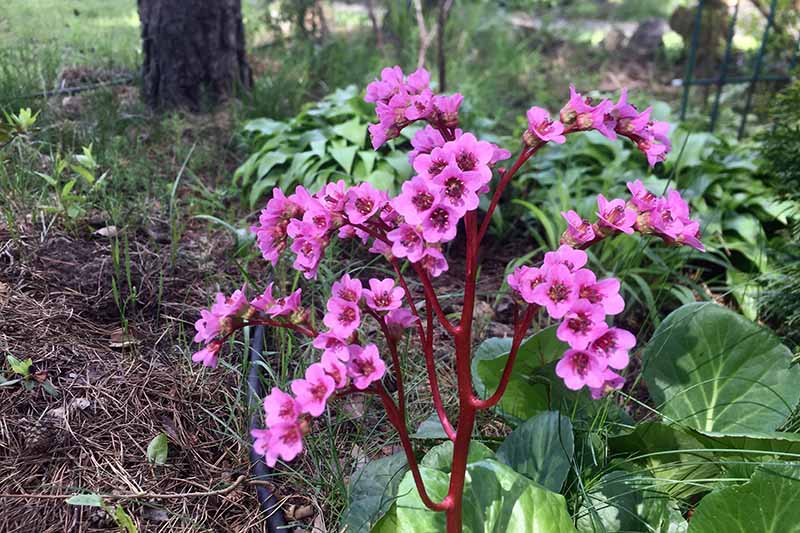
It is the most eye-catching when planted in a group.
The plant’s distinctive leaves and stunning flowers also contribute to its appeal for use in mixed borders, planted in clusters at the front.
Bergenia even makes a good container plant!
The fragrant flowers last for a long time in vases too. Cut the flowers either in the early morning or evening, and immediately place them in water. The leaves are often used in floral arrangements as well.
In addition, cut flowers can be dried and preserved.
Quick Reference Growing Guide
| Plant Type: | Flowering perennial. | Flower / Foliage Color: | Pink, purple, red, white/light to medium green, red to bronze |
| Native to: | North and central Asia | Maintenance: | Low |
| Hardiness (USDA Zone): | 2-9, depending on variety | Tolerance: | Alkaline soil, deer, drought, rabbits, salt |
| Bloom Time: | Late winter to late spring, depending on zone | Soil Type: | Organically rich |
| Exposure: | Full sun to part shade | Soil pH: | 6.5-8.5 |
| Spacing: | 15 inches | Soil Drainage: | Well-draining |
| Planting Depth: | As deep as the root ball | Attracts: | Bees, butterflies, hummingbirds |
| Height: | 1-2 feet | Companion Planting: | Coral bells, ferns, hellebores, hostas, Solomon’s seal |
| Spread: | 1-4 feet | Uses: | Ground cover, mass planting, mixed border, woodland rock gardens, containers, cut flowers, drying and preserving flowers |
| Growth Rate: | Slow | Family: | Saxifragaceae |
| Water Needs: | Moderate | Genus: | Bergenia |
| Common Pests and diseases: | Black vine weevil, slugs, snails; anthracnose, crown rot | Species: | Crassifolia/cordifolia, ciliata, emeiensis, ligulata, purpurascens, stracheyi |
A Good Plant for Beginners
How lucky for new gardeners in Zones 3 to 9 that Bergenia grows so easily!
With its attractive foliage and pretty flowers, offering multi-season interest from early spring to late fall, it’s hard to lose with this plant.
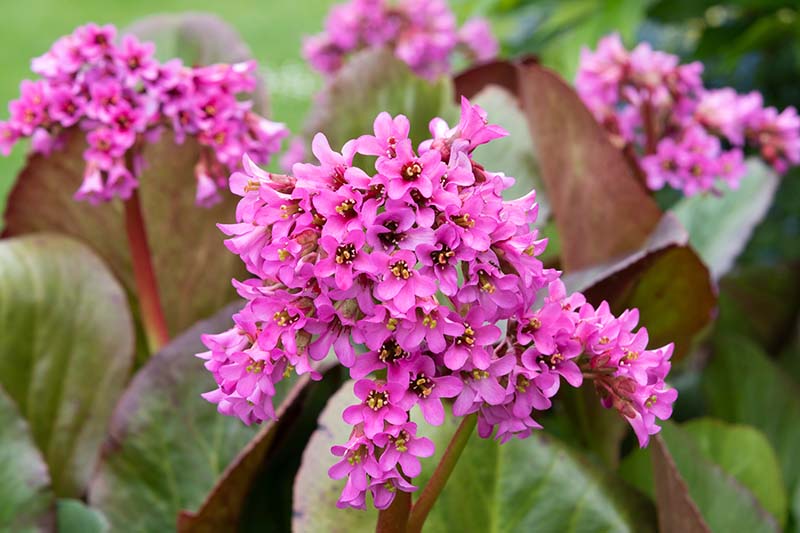
It will grow in acidic, neutral, and mildly alkaline soil, and while it prefers to be moist, it can tolerate drought once established.
Bergenia resists or tolerates almost all threats but overwatering!
We hope that this guide will inspire you to give this underused plant a chance in your garden.
Do you have any questions about growing bergenia? Ask us in the comments section below!
And for more information about growing flowers in your garden, check out these guides next:
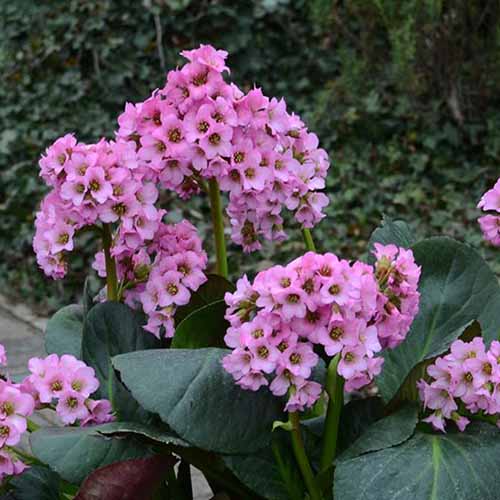
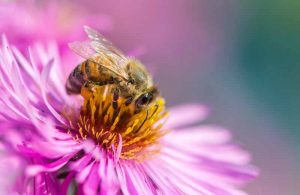

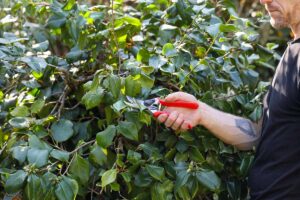
Hello! I was wondering how well do Bergenia do in containers? Thank you in advance.
Hello Angela!
It grows quite well in containers. In warmer growing areas that’s usually the best option since you’ll be able to bring them indoors when the weather gets too hot.
Make sure to plant in pots with drainage holes, though, and never overwater Bergenia. Good luck, and please share your questions or success if you decide to grow this beauty in a container.